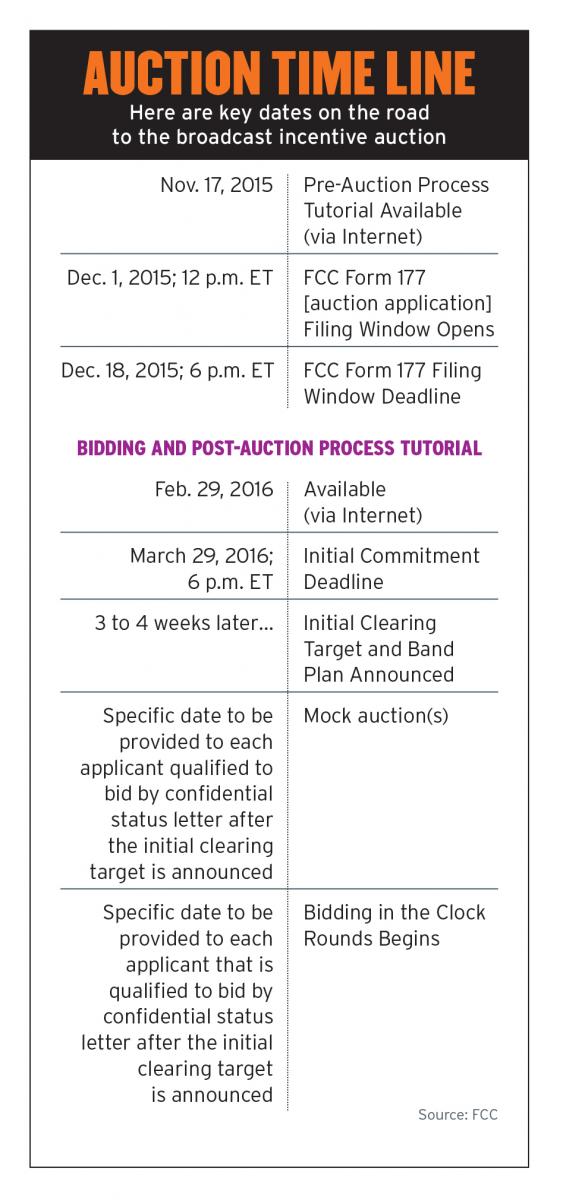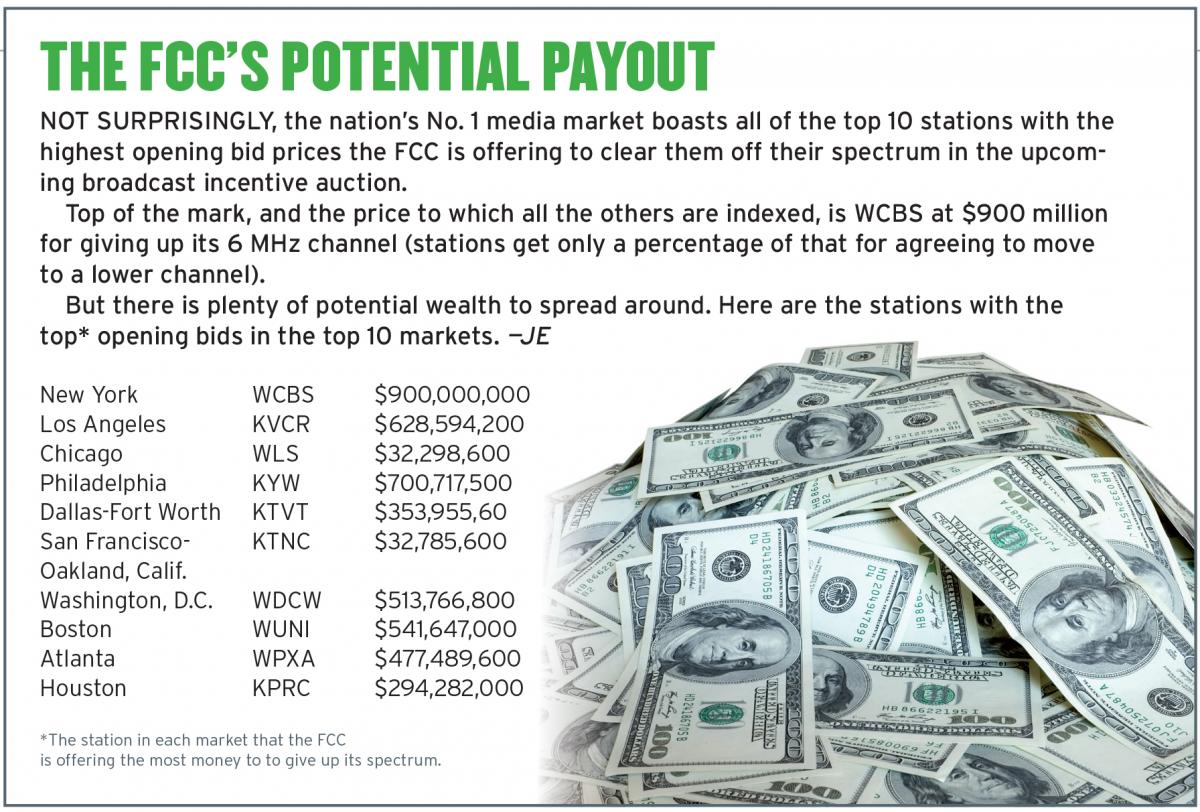Putting the ‘Action’ In the FCC’s Big Auction

Related: Stations Look to Selling, Sharing and Dropping in Lucrative Auction Frenzy
The FCC christened the broadcast incentive auction, “Auction 1001,” and the figure is mighty appropriate. If you multiply it by its importance to the future of the TV industry, the result suggests a need for a good “Auction 1001 Primer,” rather than the traditional “101.”
The FCC is trying to free up as much as 144 MHz of spectrum from broadcasters to resell to wireless broadband companies to help generate competition in the wireless space and handle the video that makes up 60% of mobile broadband traffic. It is the last such wireless spectrum auction for the foreseeable future, and one that will remake the broadcast band.
The FCC recently released the auction procedures public notice, along with the opening bid prices, which, together, FCC chairman Tom Wheeler said should give broadcasters all the information they need. Some broadcasters don’t quite agree with that assessment.
There are many options in this matter, and different price points depending on the station. WCBS New York is the top draw at $900 million with the top price. But not everyone will get a payout. (Sorry, Butte, Mont.)
Here, based on conversations with broadcasters, government officials and others who asked not to be identified, are the dozen concerns broadcasters need to be familiar with before pushing the send button on their selection (beyond the self-evident No. 1, which is that all applications must be filed electronically).
1 Keep Track of Time, Ladies and Gentlemen.
The smarter way to stay on top of broadcasting and cable industry. Sign up below
Dec. 18 (6 p.m. to be exact) is the deadline by which broadcasters have to apply to be in the auction (that application window opens Dec. 1).
That does not mean stations have to participate. It means that after that date, they can’t participate even if they wanted to. The deadline for committing to participate in the auction is March 29, which is technically the start of the auction, but more on that later as well.
After March 29, applicants who have not committed to participate, according to one or more of four scenarios, can’t participate either. So, as one FCC senior official joked (not for humorous attribution), although the train does not leave the station until March 29, TV stations getting on the train (which he could have called The Wireless Broadband Express) need to buy their tickets by Dec. 18, but the ticket is refundable.
2 Decisions, Decisions.
There are at least five options for TV stations in the auction (not counting the sixth option of not participating at all):
■ Giving up the six MHz channel and the license and moving on.
■ Giving up the six MHz channel and license but striking a deal to share spectrum with another station in the market, thus retaining the license (actually, getting a new one) and keeping the must-carry obligations that go with it.
■ A UHF station can move to a high VHF channel.
■ A UHF can move to a low VHF channel.
■ A high VHF can move to a low VHF.
The FCC will offer the full opening bid price to either the “get out” or “share” option, less for moving from a high VHF channel to a low VHF or a UHF to a low VHF, and even less for moving from a UHF to a high VHF. To check out all the discounted options, go to broadcastingcable.com/Oct26.
So, for example, a UHF or high VHF station that would get $100 million to give up all its spectrum would only get $67 million-$80 million for moving to a low VHF channel, and a UHF would get only $33 million-$50 million for moving to a high VHF channel.
“If you elect to move to VHF,” said one exec, “understand that the laws of physics apply, [along with] the impact such a move may have on possible business models and ‘use cases’ [present and future].”
3 Fasten Your Seat Belts?
The FCC’s opening bid prices are just that—starting points—and after that it is a one-way ride down. One broadcast exec said he expected them to go down quickly. The factors determining the rate of descent will depend on how many stations the FCC needs to recover in your market (there could be more than one “winner” per market), how many competitors you have and how much those competitors value their spectrum rights.

Not every price will go down, however. According to Preston Padden, the former executive director of the former Expanding Opportunities for Broadcasters Coalition, before it disbanded because of auction anti-collusion rules that are kicking in, his group ran thousands of simulations and in all of them, some number of stations, and more than a handful he said, were “frozen” at their opening bid price.
That means the FCC would have to pay that top price. But that can be looked at another way.
Another broadcaster excited about TV stations’ future with a new advanced transmission standard that could make broadcasters a player in offloading wireless traffic says that entering the auction means you’d better want to sell. “The FCC holds the option of ‘buying you out’ at whatever value you last accepted, even if it was simply the opening bid,” he said, adding, “Do not undervalue the economics of the business you could be in. Broadcasting can certainly be about a lot more than efficiently distributing ‘television.’”
4 Pull Up a Chair.
The FCC has remained faithful to chairman Tom Wheeler’s pledge of a March 29 start date. But per above, that is only the date by which broadcasters must commit to the auction.
It will still be several weeks before the actual bidding begins. According to the FCC’s just-released timetable, it could be almost a month before the commission comes up with an initial clearing target and band plan. The clearing target is how much spectrum it expects to clear based on the stations that have committed to giving up spectrum at the initial bid price. The band plan is how TV stations remaining on the air will be repacked into the remaining spectrum.
One D.C. broadcast executive who has been keeping a close eye on the auction set-up suggested the forward auction could still be going on in early 2017.
5 It Ain’t Over Till It’s Over—and Maybe Not Even Then.
The FCC will set a target amount of spectrum it plans to clear (clearing target), then hold the auction. But if at the end it has failed to draw enough broadcasters to the auction to hit that target, it will need to set a new, smaller clearing target, and continue until it meets that next goal, or the next.
Broadcasters who have dropped out will still be out, but those who were “frozen” at their last bid will be unfrozen and the bidding will continue until the FCC meets a clearing target.
6 Insurance Policy.
The National Association of Broadcasters has taken the FCC to task for deciding to repack only TV stations that don’t participate in the auction in the wireless spectrum including that dreaded “duplex gap” between wireless uplink and downlink spectrum. But one broadcast exec said one way to avoid that is to go ahead and commit to the auction. Given that only a handful of stations will get that opening payout, odds are that would permit a station to drop out of the auction the minute the price dropped, allowing it to protect itself from repacking in the wireless band. Of course, it could gamble and lose and have to give up spectrum. But losing would be getting that high starting price.
7 Sharing With Yourself.
For owners with duopolies, sharing spectrum would appear to be a no-brainer, said one exec. Striking the sharing agreement would be easy, and the money the sharing station gets from the moving station stays in the corporate family.
But one exec advises paying close attention to the sharing rules in general.
“If you plan on channel-sharing, make sure you have done your homework regarding partners,” he said, “and make sure you understand the limitations such sharing may bring to the business and your capacity to evolve the nature of your broadcast business.”
8 Get a Lawyer (Natch).
Anyone considering entering the auction needs to check out the FCC’s updated guidance on prohibited communications, particularly if their attorney is representing more than one station owner.

The FCC will prohibit communicating how a licensee will participate in the auction—bids and bidding strategies—but an owner can say “whether” a licensee has or hasn’t applied to participate.
The FCC is nixing certain communications between and among participants in both the reverse (broadcaster) auction and forward (wireless) auction. But it also recognizes that companies need to keep conducting their businesses.
The prohibitions do not include necessary communication of bidding or strategy information to third parties including legal counsel, lenders or consultants, so long as the licensee takes steps to insure that third party does not share it with other auction participants.
But violators of the rules will be prosecuted, the FCC signaled. Penalties could include “forfeiture of reverse auction winning bid incentive payments” and license revocation.
The FCC has also carved out an exception for parties to a channel-sharing agreement, but to do so those agreements need to be struck by Dec. 18.
9 Practice Makes Perfect.
Get those mock bids ready. Given the number of broadcasters the FCC said it expects to participate in the auction, it anticipates it will be holding at least two mock auctions beforehand to let all those broadcasters kick the tires and test the software, but broadcasters may have to pick one, rather than getting two practice runs. The FCC says broadcasters will be able to participate in at least one, and an FCC spokesperson did not rule out a second chance.
Bidding is online, but an FCC spokesperson said there will be phone backup in case of technical issues.
10 Price Check.
The FCC has assigned each station an opening bid price, which is based on a combination of its viewership (population served) and the degree to which reclaiming its spectrum impacts the repack of stations after the auction.
The more potential interference to other stations being repacked in a smaller spectrum space, the more the FCC wants not to have to repack that station.
Currently, broadcasters are using ch. 51 and down, though they eventually have to exit 51 per the previous, 700 MHz auction. After the auction, broadcasters will have to be repacked into ch. 44 and down if the FCC is only able to clear its minimum target of 42 MHz and only ch. 26 and down if the FCC clears its maximum of 144 MHz.
11 Transparency, FCC Style.
The FCC will identify winning bidders after those bidders have been chosen. But it will also identify the losing bidders after two years. Station owners will have until then to figure out how to tell employees the station had been on the block.
12 Ignorance Isn’t Bliss.
While the FCC says broadcasters should have all the info they need, one broadcaster suggested that assessment fell short of the mark, saying one thing broadcasters need to know is how much they still don’t know.
Another broadcast exec following the auction process in D.C. closely agrees. He concedes it may be unknowable, but broadcasters don’t know how long the auction will take and just how many auctions there might be. He points out that the FCC can “stop, pause, restart or do-over the auction at any time” and that broadcasters are concerned that they don’t know under what conditions the FCC might do that—say, for instance, if they don’t like the bids they’re getting.
An FCC official conceded that both broadcasters and the FCC are facing a new and unique experience. That is putting it mildly.
Contributing editor John Eggerton has been an editor and/or writer on media regulation, legislation and policy for over four decades, including covering the FCC, FTC, Congress, the major media trade associations, and the federal courts. In addition to Multichannel News and Broadcasting + Cable, his work has appeared in Radio World, TV Technology, TV Fax, This Week in Consumer Electronics, Variety and the Encyclopedia Britannica.

